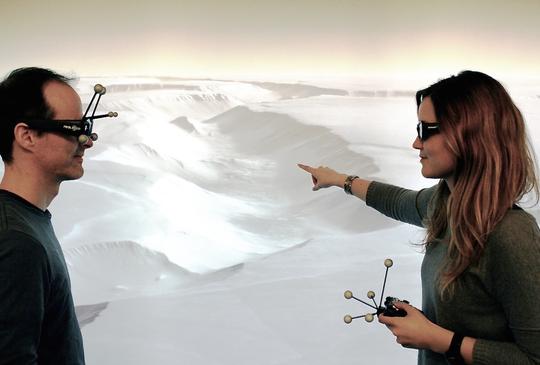
Inside the THINKlab at the University of Salford
-
On the seventh floor of Salford University’s iconic Maxwell Building, tucked away at the far end of a long corridor, sits the THINKlab, a state-of-the-art ‘centre for the future.’
Set up in 2006, THINKlab is part of the University’s School of the Built Environment and has a full-time staff of four, headed up by Professor Terrence Fernando and supported by a clutch of research fellows.
Billed as ‘an innovative space to think’, the centre leads research into digital media, ICT platforms for urban regeneration, collaborative engineering and multi-media services.
Collaboration is the key behind much of the research the lab carries out, and Fernando talks about an “interdisciplinary approach” that is essential to solving complex social, economic and environmental challenges, and promoting innovation.
Data, and how it is used, is at the core of much of this work, and there is a strong emphasis on visualisation and interaction as the best way of exploring potential solutions and their impacts.
Alongside a diverse portfolio of projects, ranging from support for the ExoMars 2016 expedition, to an interactive model of how a regeneration scheme in Pendleton will look, THINKlab is also working on two key European projects linked to the idea of sustainable cities.
Design4Energy is looking at new ways to predict the current and future energy efficiency of buildings, both individually and at a neighbourhood level. Its aim, says Fernando, is to support better decision making when it comes to optimising the energy performance of a building over its entire life.
The project is supporting efforts to scale up work being done to create more low energy buildings at a district level. THINKlab’s role is to develop a single, interactive 3D virtual workplace that will allow the project’s various partners – from architects to town planners – to assess the impact of different energy solutions and explore different scenarios.
The project is using data from housing developments in Poland, Germany and Spain, where sensors are being used in individual homes to gather the information needed to build up a picture around factors such as temperature and humidity, which shows patterns and give clues to how that house is performing.
“It’s a way of giving professional architects the tools to design more efficient buildings and make better informed solutions,” explains Fernando. “The data already exists, what THINKlab does is allow people to collaborate and share it.
“We can bring the data into an interactive environment where people can better understand it… and create a richer interpretation of the city,”
“We can bring the data into an interactive environment where people can better understand it… and create a richer interpretation of the city,” he says, as well as using it to develop a series of ‘what if’ scenarios, using different parameters and exploring different design options.
Renewables are also a big feature of many new housing developments. Design4Energy is taking this into account, along with the likely growth of energy trading, when home owners sell back unused energy generated through renewable sources such as photovoltaic cells on a local level, powering everything from street lights to their next door neighbour’s kettle.

“Our role is to create a technology platform where some of these models and simulations can be integrated into one place and stakeholders can work out the best combinations of renewable energy resources, and storage facilities within each house or community,” he says.
The project also teaches lessons about how people use their homes and their attitudes towards energy efficiency, information which in turn can then feed into retrofit programmes.
A second project, ProSEco, is also about collecting and interpreting data. Many new generation products, from white goods to cars now have built-in sensors that can be used to collect data as they’re being used.
In a washing machine, for instance, a sensor could detect the hardness of water and suggest a particular detergent, or by monitoring how people use a machine, manufacturers can change the design and make it more user-friendly.
The project also involves sensors on cars, which can pick up driver behaviour, pollution levels, traffic patterns and even the condition of the road. Planners can then use this information in their transport strategies, says Fernando, while car manufacturers are looking at how they can use the information to develop a device that automatically switches a car over to eco mode when it enters an area of the city that has historically suffered from high pollution.
“Sometimes the data tells you a story that we don’t understand, patterns that the human brain can’t really see. What we can do is crunch the numbers, analysis the data and create a narrative,” says Fernando.
To find out more about THINKlab click here.
Perspectives essay: social arts, creative flux and citizen led innovation
Contributed by Paul Haywood
Trapped in techno-scientism; is this hindering our becoming an eco-city?
Contributed by Nadine Andrews
Contributor Profile
Mark Hillsdon is a freelance writer with a passion for nature and the great outdoors. A regular contributor to magazines such as Coast and CountryFile, he also writes on sustainability for the Guardian, and the occasional travel piece for the Independent. On Sunday. He has also been writing on all things Mancunian since first getting off the Euston train as a student nearly 30 years ago.




